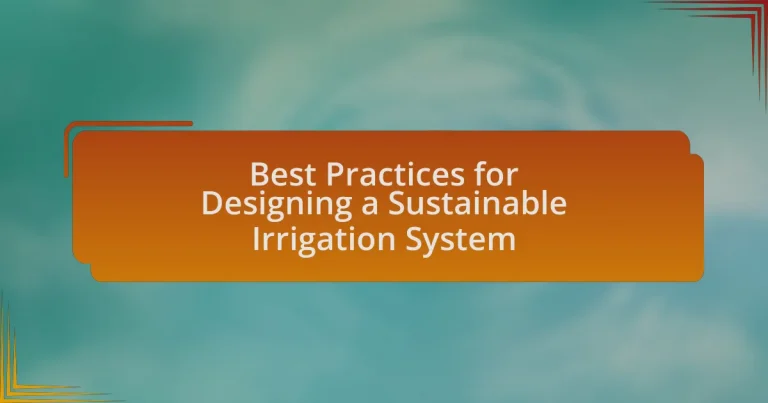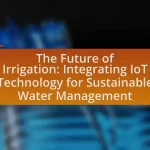The article focuses on best practices for designing a sustainable irrigation system, emphasizing key principles such as efficient water use, soil health maintenance, and the integration of local climate conditions. It discusses the environmental impacts of traditional irrigation methods and highlights how sustainable practices, including drip irrigation and rainwater harvesting, can mitigate these effects. The article also examines the role of modern technologies, such as soil moisture sensors and renewable energy sources, in enhancing irrigation efficiency and sustainability. Additionally, it addresses challenges in implementing sustainable systems and offers practical tips for effective water resource management.
What are the key principles of designing a sustainable irrigation system?
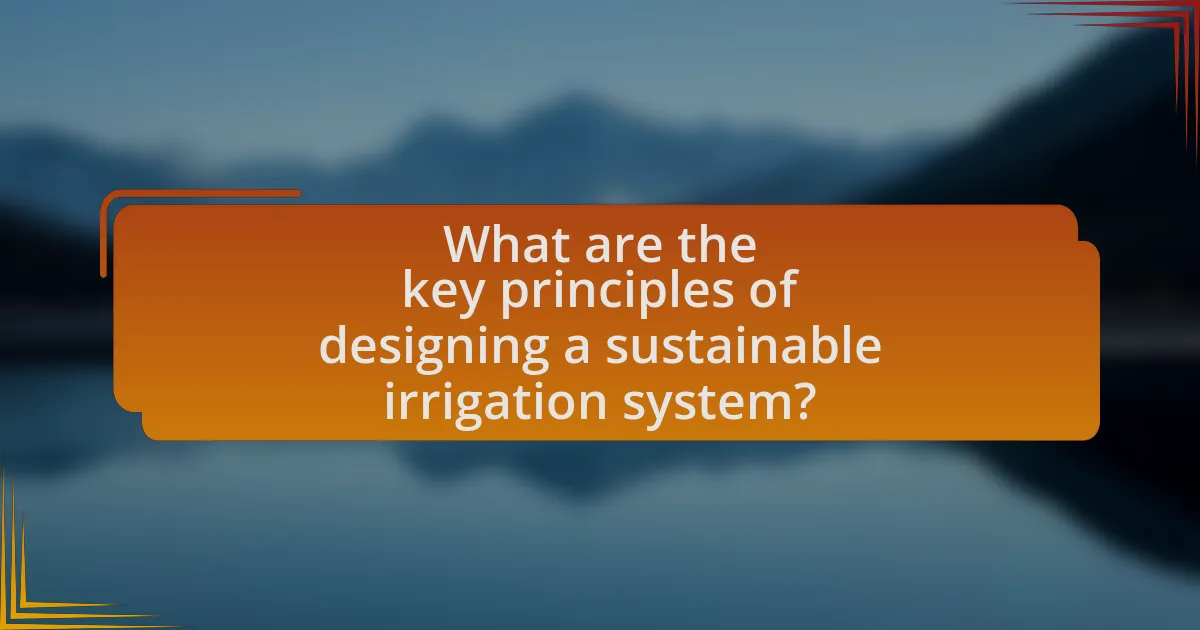
The key principles of designing a sustainable irrigation system include efficient water use, soil health maintenance, and integration of local climate conditions. Efficient water use involves employing technologies such as drip irrigation and rainwater harvesting to minimize waste and maximize crop yield. Soil health maintenance focuses on practices like crop rotation and organic amendments to enhance soil structure and fertility, which in turn improves water retention and reduces the need for irrigation. Integration of local climate conditions ensures that the irrigation system is tailored to the specific weather patterns and water availability of the region, promoting resilience against droughts and floods. These principles collectively contribute to the sustainability of agricultural practices and resource conservation.
How does sustainability influence irrigation design?
Sustainability significantly influences irrigation design by prioritizing water conservation, efficiency, and environmental impact. Sustainable irrigation systems incorporate technologies such as drip irrigation and rainwater harvesting, which minimize water waste and enhance resource management. For instance, drip irrigation can reduce water usage by up to 60% compared to traditional methods, demonstrating a clear benefit in conserving water resources. Additionally, sustainable designs often include soil moisture sensors and weather-based controllers, which optimize irrigation schedules based on real-time data, further promoting efficient water use. These practices not only support agricultural productivity but also protect local ecosystems and reduce the carbon footprint associated with water transport and usage.
What are the environmental impacts of traditional irrigation systems?
Traditional irrigation systems can lead to significant environmental impacts, including soil degradation, water scarcity, and habitat destruction. These systems often rely on surface water sources, which can result in the over-extraction of water, leading to reduced river flows and negatively affecting aquatic ecosystems. Additionally, the continuous flooding of fields can cause soil salinization, reducing agricultural productivity and harming soil health. Furthermore, traditional irrigation practices may disrupt local wildlife habitats, as water diversion alters natural landscapes and ecosystems.
How can sustainable practices mitigate these impacts?
Sustainable practices can mitigate the negative impacts of irrigation systems by promoting efficient water use and reducing environmental degradation. Implementing techniques such as drip irrigation minimizes water waste by delivering water directly to plant roots, which can reduce overall water consumption by up to 60% compared to traditional methods. Additionally, using native plants in landscaping requires less water and maintenance, further conserving resources. Integrating rainwater harvesting systems captures and utilizes natural precipitation, decreasing reliance on groundwater and surface water sources. These practices collectively enhance water conservation, improve soil health, and reduce the risk of salinization, thereby fostering a more sustainable agricultural ecosystem.
What factors should be considered in sustainable irrigation design?
Sustainable irrigation design should consider water efficiency, soil health, crop requirements, and environmental impact. Water efficiency involves selecting systems that minimize water loss, such as drip irrigation, which can reduce water usage by up to 60% compared to traditional methods. Soil health is crucial, as practices like mulching and cover cropping enhance soil moisture retention and fertility. Understanding crop requirements ensures that irrigation meets the specific needs of different plants, optimizing growth and yield. Lastly, assessing environmental impact includes evaluating effects on local ecosystems and water sources, promoting practices that protect biodiversity and reduce runoff.
How do soil types affect irrigation system choices?
Soil types significantly influence irrigation system choices by determining water retention, drainage capacity, and nutrient availability. For instance, sandy soils drain quickly and require more frequent irrigation, making drip or sprinkler systems more suitable to ensure adequate moisture. Conversely, clay soils retain water well but can lead to waterlogging; thus, surface irrigation or subsurface drainage systems may be preferred to manage excess water. Research indicates that understanding soil texture and structure is crucial for optimizing irrigation efficiency and crop yield, as highlighted in studies by the USDA Natural Resources Conservation Service, which emphasize the relationship between soil characteristics and irrigation practices.
What role does climate play in irrigation system design?
Climate significantly influences irrigation system design by determining water availability, evaporation rates, and crop water requirements. For instance, arid regions necessitate systems that maximize water conservation, such as drip irrigation, while humid areas may benefit from simpler surface irrigation methods. Additionally, temperature and precipitation patterns inform the scheduling and efficiency of irrigation practices, ensuring that water is applied when crops need it most. Understanding local climate conditions is essential for optimizing irrigation strategies, as evidenced by studies showing that tailored irrigation practices can improve crop yields by up to 30% in varying climates.
What technologies are available for sustainable irrigation systems?
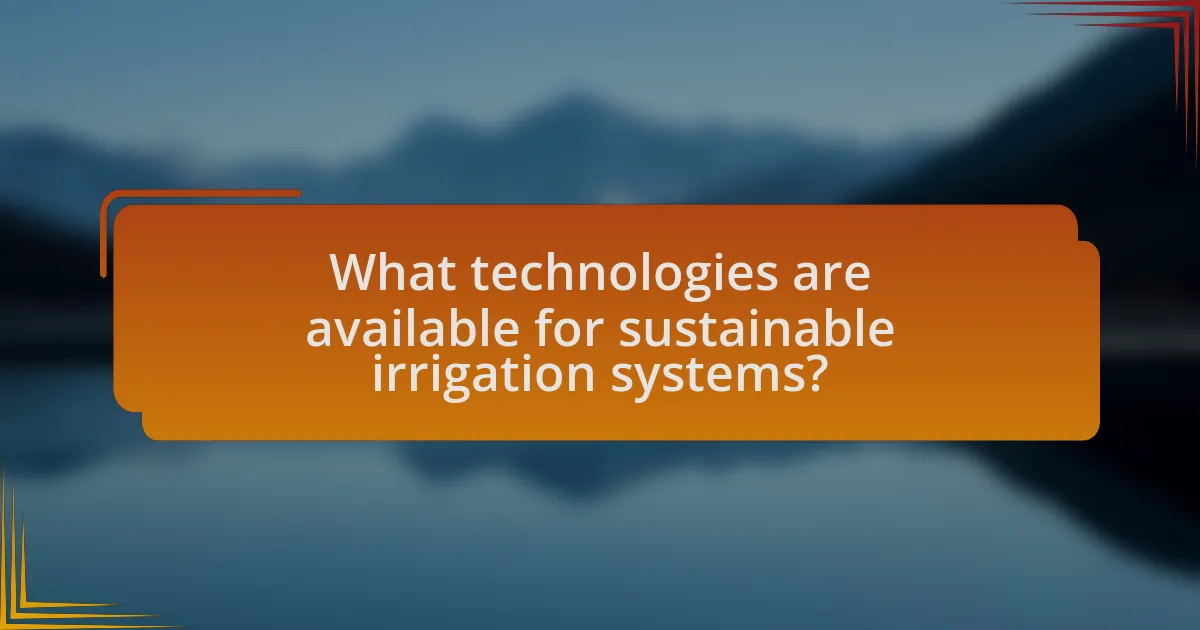
Technologies available for sustainable irrigation systems include drip irrigation, sprinkler systems, soil moisture sensors, and rainwater harvesting systems. Drip irrigation delivers water directly to the plant roots, minimizing evaporation and runoff, which can increase water efficiency by up to 90% compared to traditional methods. Sprinkler systems can be designed to reduce water waste through advanced scheduling and zoning. Soil moisture sensors provide real-time data on soil conditions, allowing for precise irrigation based on actual needs, which can reduce water usage by 30-50%. Rainwater harvesting systems capture and store rainwater for irrigation, promoting water conservation and reducing reliance on municipal water supplies. These technologies collectively contribute to more efficient water use and sustainable agricultural practices.
How do modern irrigation technologies enhance sustainability?
Modern irrigation technologies enhance sustainability by optimizing water usage and reducing waste. These technologies, such as drip irrigation and smart irrigation systems, deliver water directly to the plant roots, minimizing evaporation and runoff. For instance, drip irrigation can reduce water usage by up to 60% compared to traditional methods, significantly conserving water resources. Additionally, smart irrigation systems utilize sensors and weather data to adjust watering schedules, ensuring that plants receive the right amount of water at the right time, further promoting efficient water management. This precision in irrigation not only conserves water but also improves crop yields and reduces the environmental impact of agriculture.
What are the benefits of drip irrigation systems?
Drip irrigation systems provide efficient water usage, delivering water directly to the plant roots, which minimizes evaporation and runoff. This targeted approach can reduce water consumption by up to 50% compared to traditional irrigation methods, making it particularly beneficial in arid regions. Additionally, drip irrigation promotes healthier plant growth by ensuring consistent moisture levels and reducing the risk of disease associated with wet foliage. Studies have shown that crops irrigated with drip systems often yield higher outputs, enhancing agricultural productivity.
How does smart irrigation technology optimize water usage?
Smart irrigation technology optimizes water usage by utilizing sensors and data analytics to deliver precise amounts of water based on real-time environmental conditions. This technology monitors soil moisture levels, weather forecasts, and plant water requirements, allowing for targeted irrigation that reduces waste. For instance, studies have shown that smart irrigation systems can reduce water usage by up to 30% compared to traditional methods, as they apply water only when necessary, preventing over-irrigation and runoff.
What are the advantages of using renewable energy in irrigation systems?
The advantages of using renewable energy in irrigation systems include reduced operational costs, environmental sustainability, and increased energy independence. Renewable energy sources, such as solar and wind, can significantly lower electricity expenses associated with pumping water, as they often have lower long-term costs compared to fossil fuels. Additionally, utilizing renewable energy minimizes greenhouse gas emissions, contributing to a more sustainable agricultural practice. For instance, a study by the International Renewable Energy Agency found that solar-powered irrigation can reduce energy costs by up to 90% compared to conventional systems. This shift not only supports farmers economically but also promotes a cleaner environment.
How can solar energy be integrated into irrigation practices?
Solar energy can be integrated into irrigation practices by utilizing solar-powered pumps and systems that harness sunlight to operate irrigation equipment. These solar pumps convert solar energy into mechanical energy, allowing for efficient water extraction from sources such as wells or surface water bodies. According to the International Renewable Energy Agency, solar irrigation systems can reduce operational costs by up to 90% compared to diesel-powered systems, making them a sustainable choice for farmers. Additionally, the use of solar energy in irrigation can enhance water management by enabling automated irrigation scheduling, which optimizes water usage and improves crop yields.
What are the cost implications of renewable energy in irrigation?
The cost implications of renewable energy in irrigation primarily involve initial investment, operational savings, and long-term economic benefits. Implementing renewable energy sources, such as solar or wind, typically requires a higher upfront capital expenditure for equipment and installation compared to conventional energy sources. However, these systems often lead to significant reductions in operational costs over time due to lower energy bills and maintenance expenses. For instance, a study by the International Renewable Energy Agency (IRENA) found that solar-powered irrigation systems can reduce energy costs by up to 80% compared to diesel-powered systems. Additionally, the long-term benefits include increased resilience to energy price fluctuations and potential government incentives for adopting renewable technologies, which can further offset initial costs.
What best practices should be followed for implementing a sustainable irrigation system?
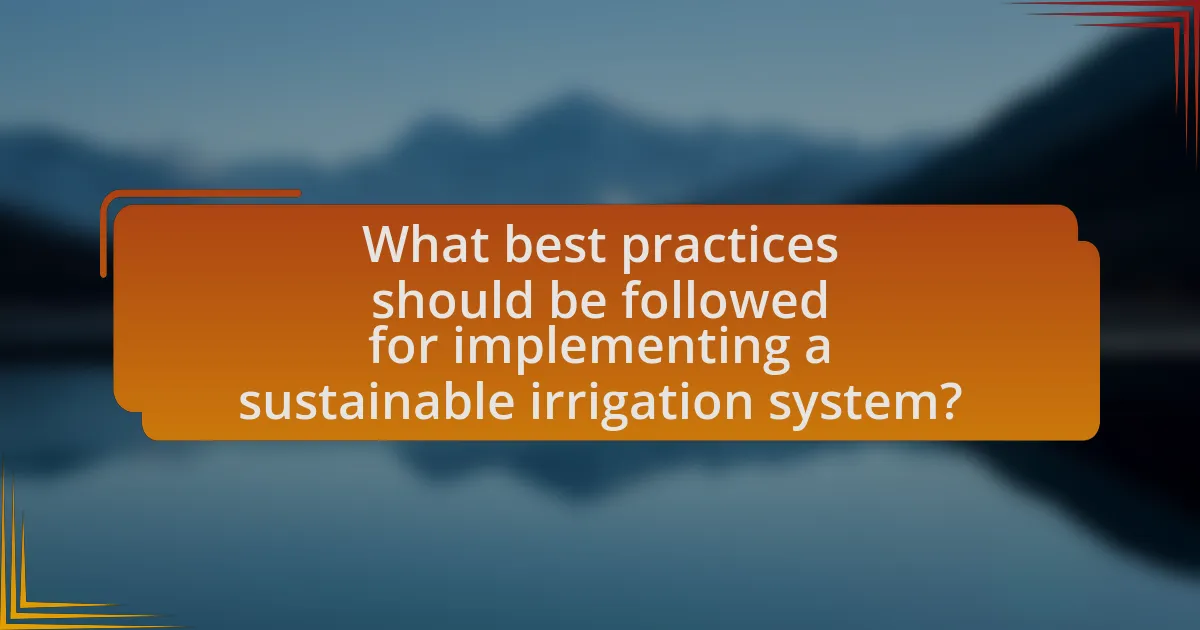
To implement a sustainable irrigation system, best practices include utilizing efficient irrigation technologies, such as drip or sprinkler systems, which minimize water waste. These technologies deliver water directly to the plant roots, reducing evaporation and runoff. Additionally, scheduling irrigation based on weather conditions and soil moisture levels ensures that water is applied only when necessary, further conserving resources. Implementing rainwater harvesting systems can also enhance sustainability by capturing and using natural precipitation. Regular maintenance of irrigation systems is crucial to prevent leaks and inefficiencies, which can lead to significant water loss. According to the Food and Agriculture Organization, adopting these practices can improve water use efficiency by up to 50%, demonstrating their effectiveness in promoting sustainable irrigation.
How can farmers effectively manage water resources?
Farmers can effectively manage water resources by implementing precision irrigation techniques, which optimize water use and minimize waste. Precision irrigation involves using technology such as soil moisture sensors and weather data to determine the exact water needs of crops, ensuring that water is applied only when necessary and in the right amounts. Research indicates that precision irrigation can reduce water usage by up to 30% while maintaining crop yields, as demonstrated in studies conducted by the University of California Agriculture and Natural Resources. This approach not only conserves water but also enhances crop health and productivity, making it a vital practice for sustainable agriculture.
What techniques can be used for rainwater harvesting?
Techniques for rainwater harvesting include rooftop collection, surface runoff harvesting, and subsurface storage. Rooftop collection involves directing rainwater from roofs into storage tanks, which can capture significant amounts of water, especially in urban areas. Surface runoff harvesting captures rainwater from land surfaces, directing it into ponds or reservoirs, which can be particularly effective in agricultural settings. Subsurface storage techniques, such as aquifer recharge, involve infiltrating rainwater into the ground to replenish groundwater supplies. These methods are supported by studies indicating that rainwater harvesting can significantly reduce water scarcity and improve water quality in various regions.
How can crop rotation improve irrigation efficiency?
Crop rotation can improve irrigation efficiency by enhancing soil structure and moisture retention. Different crops have varying root depths and nutrient requirements, which can lead to better water infiltration and reduced runoff. For instance, deep-rooted plants can access moisture from deeper soil layers, while cover crops can improve soil organic matter, promoting better water retention. Research indicates that fields with diverse crop rotations can reduce irrigation needs by up to 30% compared to monoculture systems, as demonstrated in studies conducted by the USDA Agricultural Research Service.
What are common challenges in designing sustainable irrigation systems?
Common challenges in designing sustainable irrigation systems include water scarcity, soil degradation, and economic constraints. Water scarcity affects the availability of resources needed for irrigation, making it difficult to implement effective systems. Soil degradation, often caused by overuse and poor management practices, reduces the land’s productivity and complicates irrigation efforts. Economic constraints limit the ability to invest in advanced technologies and infrastructure necessary for sustainable practices. According to the Food and Agriculture Organization, approximately 70% of freshwater resources are used for irrigation, highlighting the critical need for efficient water management to address these challenges.
How can water scarcity be addressed in irrigation planning?
Water scarcity can be addressed in irrigation planning by implementing efficient water management practices such as drip irrigation, rainwater harvesting, and crop selection based on water availability. Drip irrigation minimizes water loss by delivering water directly to the plant roots, which can reduce water usage by up to 60% compared to traditional methods. Rainwater harvesting captures and stores rainwater for irrigation, providing an alternative water source and reducing reliance on groundwater. Additionally, selecting drought-resistant crops can optimize water use and enhance resilience to water scarcity. These practices are supported by studies indicating that efficient irrigation systems can significantly improve water conservation and agricultural productivity.
What strategies can be employed to overcome financial barriers?
To overcome financial barriers in designing a sustainable irrigation system, stakeholders can employ strategies such as securing grants, forming partnerships, and utilizing cost-sharing programs. Securing grants from government agencies or non-profit organizations can provide essential funding, as evidenced by the USDA’s Agricultural Conservation Easement Program, which offers financial assistance for sustainable practices. Forming partnerships with local governments or agricultural cooperatives can also enhance resource sharing and reduce individual costs. Additionally, utilizing cost-sharing programs, like those offered by the Environmental Quality Incentives Program, allows farmers to receive financial support for implementing sustainable irrigation practices, thereby alleviating financial burdens.
What practical tips can be applied for successful sustainable irrigation design?
Successful sustainable irrigation design can be achieved by implementing efficient water management practices. Utilizing drip irrigation systems minimizes water waste by delivering water directly to plant roots, which can reduce water usage by up to 60% compared to traditional methods. Additionally, incorporating rainwater harvesting systems captures and stores rainwater for irrigation, further conserving resources.
Soil moisture sensors can optimize irrigation schedules by providing real-time data on soil conditions, ensuring that water is applied only when necessary. Furthermore, selecting drought-resistant plant species can significantly lower irrigation demands, as these plants require less water to thrive.
Regular maintenance of irrigation systems is crucial to prevent leaks and inefficiencies, which can waste significant amounts of water. Lastly, educating users about sustainable practices enhances community engagement and promotes long-term sustainability in irrigation design.
